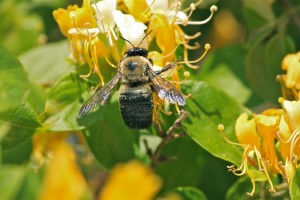12
Jul
Canadian Environmental Groups Sue to Stop Bee-Toxic Pesticide Use
(Beyond Pesticides, July 12, 2016) Canadian environmental organizations sued the Canadian Pest Management Regulatory Agency (PRMA) last week in a bid to overturn the approval of two neonicotinoid pesticides linked to the decline of honey bees and wild pollinators. The move comes amid growing awareness, action, and scientific evidence linking this widely used class of insecticides to the global decline of pollinator populations.
 The lawsuit, filed by Ecojustice on behalf of The David Suzuki Foundation, Friends of the Earth Canada, Ontario Nature, and the Wilderness Committee, argues that pesticide products containing two neonicotinoids, clothianidin and thiamethoxam, are unlawfully registered in Canada. The groups allege that PMRA failed to ensure that it had the data necessary to determine the environmental risks, particularly those concerning pollinators, posed by the chemicals. “The PMRA has taken a see-no-evil, hear-no-evil, speak-no-evil approach by repeatedly registering these neonicotinoid pesticides without important scientific information on their risks to pollinators,” said Charles Hatt, staff lawyer at Ecojustice.
The lawsuit, filed by Ecojustice on behalf of The David Suzuki Foundation, Friends of the Earth Canada, Ontario Nature, and the Wilderness Committee, argues that pesticide products containing two neonicotinoids, clothianidin and thiamethoxam, are unlawfully registered in Canada. The groups allege that PMRA failed to ensure that it had the data necessary to determine the environmental risks, particularly those concerning pollinators, posed by the chemicals. “The PMRA has taken a see-no-evil, hear-no-evil, speak-no-evil approach by repeatedly registering these neonicotinoid pesticides without important scientific information on their risks to pollinators,” said Charles Hatt, staff lawyer at Ecojustice.
Under Canada’s Pest Control Products Act, PMRA must have “reasonable certainty” that a pesticide will not cause harm to the environment before it is registered. The groups also note that several thiamethoxam-based products have been registered by the agency for years without a mandated public consultation period.
“Pollinators are key players in our ecosystems, and their declines are extremely concerning. A stunning variety of plants ”” including fruits, vegetables, nuts, and 90 per cent of flowering plants ”” need pollinators to reproduce and thrive,” said Anne Bell, PhD, Director of Conservation and Education at Ontario Nature.
Although PMRA has not taken substantial action to restrict neonicotinoids, certain Canadian provinces and cities have begun eliminating significant uses of these chemicals. Last year, Ontario became the first jurisdiction in North America to restrict the use of neonicotinoid coated seeds, limiting acreage planted with these toxic seeds by 80% by 2017. “The Province of Ontario recently brought in strong restrictions on the use of dangerous neonicotinoid pesticides in agriculture,” said Faisal Moola, PhD, Director General of Ontario and Northern Canada at the David Suzuki Foundation. “We’re hoping that our court case will compel the federal government to take similar action in response to widespread public concern over the fate of pollinators in Canada.” Neonicotinoid coated seeds have been implicated in massive bee kills as a result of “fugitive dust” that sloughs off and drifts during planting, contaminating bee-attractive plants nearby. A report by the American Bird Conservancy found that a single neonic-coated corn kernel was enough to kill a songbird. A study by the U.S. Environmental Protection Agency (EPA) found that neonicotinoid soybean seed treatments offered little to no benefit to farmers in terms of pest control or increased economic well-being.
Late last year, the Quebec city of Montreal moved to completely ban the use of neonicotinoids within the city, following similar moves in the U.S., where local governments in Minneapolis, MN, Lafayette and Boulder, CO, Portland, OR, Montgomery County, MD, and numerous other locations have restricted or eliminated the use of neonicotinoids on public and/or private property.
Federal action in the U.S to restrict neonicotinoids has been equally as lackluster as Canada’s response. Although federal agency have announced some pollinator protective measures as part of the National Pollinator Health Strategy, and EPA has acknowledged the neonicotinoid imidacloprid presents acute risks to pollinators, these moves have largely been seen as inadequate. The agency continues to approve other bee-toxic pesticides, like sulfoxaflor, despite evidence showing unacceptable adverse impacts to pollinators, and court cases to back up these claims.
In 2013, Beyond Pesticides joined with beekeepers and environmental allies in a lawsuit similar to the one recently launched in Canada, challenging EPA’s approval of thiamethoxam and clothianidin. These highly toxic, persistent and systemic chemicals have been widely implicated as leading factors in pollinator declines. For a primer on the pollinator crisis, see the lawsuit’s Press Release. Also, read the 2013 Lawsuit, Appendix A: Clothianidin, and Appendix B: Thiamethoxam.
For more information on how you can take action to protect pollinators in your community, and advocate for change at the federal level, see Beyond Pesticides BEE Protective program page.
All unattributed positions and opinions in this piece are those of Beyond Pesticides.
Source: Commondreams.org, Montreal Gazette










